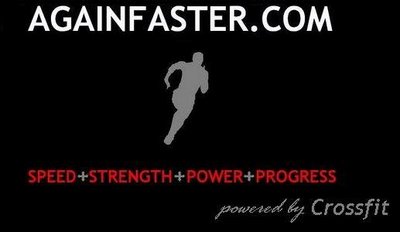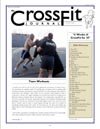Know Squat

The squat is extremely functional. You know this. You're enlightened.
You do all kinds of squats--bodyweight, front, back, and overhead. You have superior posterior chain development, and you owe it all to the squat.
You scoff at trainers who claim you should only squat to parallel. Ass-to-grass, baby. When your buddies ask you how to get huge lats and a ripped upper body, you enigmatically tell them to squat. They look at you funny, and you love it.
You clearly know the full-body benefits of the squat--speed, strength, and power. You've derived these benefits yourself, and you're happy to tell anyone who asks all about them.
Hold up, Squat-boy. I have a feeling you don't squat correctly.
A point I've beaten to death: we have a tendency to sacrifice form for speed. When I do bodyweight squats as part of a timed WOD, I feel my heels coming up and my chest going down. I'm trying to speed through an exercise that requires good form, and it shows.
By now, you probably know how a good squat feels. You're chest is up, your lower lumbar curve is pronounced, and your pelvis is anteriorly tilted. You've got your weight on your heels. In the bottom position, you can feel tension throughout your body, and your torso is as vertical as possible. In the top position, that tension remains, and you're fully extended.
If you don't know what the hell I'm talking about, try this. Stand up. Put your feet slightly outside shoulder-width. Now make like a superhero. Push your chest out, and tilt your pelvis forward by arching your back and pulling your butt rearward. Maintaining this position, place the index and middle fingers of each hand on your pelvis, in the spot where your hips bend.
Now squat, and try and crush your fingers in your hips. Keep your chest up, and your back arched. If you feel yourself pitching forward, stop. You've reached the limits of your current flexibility. Going any deeper is just going to hurt your form in the long run.
Quit reading, and try it, you goddamn desk jockey...
I bet that felt a lot different than your current squat. This is a difficult movement, and we have a tendency to presume competence and move on, in search of more exciting exercises.
According to Greg Glassman, the founder of Crossfit, a mature squat takes 3-5 years to develop. Since we've got some time, I thought I'd share a few training tips.
Will Tagye gave me this one. You'll need a training partner to pull it off.
Put a piece of paper under one of your heels. Your partner should kneel beside you, and put tension on the paper, like they're trying to pull it out from under your shoe. If you don't keep your weight on your heels throughout the squat, this will instantly diagnose the problem--you partner will be standing next to you, waving the paper you were supposed to keep under you.
If you're the holder, give your trainee a paper cut everytime they screw up. There's a little extra motivation.
Maintaining the arch in the lower back is difficult. Keeping the chest up helps with this problem. The other day, I was doing bodyweight squats, 450 in total. As I noticed my form slipping, I put my arms in the rack position with my forearms held parallel to the ground.
This is the same position your arms are in during the front squat: hands on your clavicle, with your palms facing upward, your elbows extended in front, forearms parallel to the ground. This forces you to keep your chest up and your back arched. If you fail, your arms will fall below parallel, instantly betraying your sh*tty form. As a bonus, this skill set easily transfers to the front squat.
The overhead, front, and back squats each have subtle nuances. Despite the smaller details, a solid base, strong arch, and an upright torso will help with every squat you do.
Take the time to do them right. You may have a good squat come 2009.

The squat is extremely functional. You know this. You're enlightened.
You do all kinds of squats--bodyweight, front, back, and overhead. You have superior posterior chain development, and you owe it all to the squat.
You scoff at trainers who claim you should only squat to parallel. Ass-to-grass, baby. When your buddies ask you how to get huge lats and a ripped upper body, you enigmatically tell them to squat. They look at you funny, and you love it.
You clearly know the full-body benefits of the squat--speed, strength, and power. You've derived these benefits yourself, and you're happy to tell anyone who asks all about them.
Hold up, Squat-boy. I have a feeling you don't squat correctly.
A point I've beaten to death: we have a tendency to sacrifice form for speed. When I do bodyweight squats as part of a timed WOD, I feel my heels coming up and my chest going down. I'm trying to speed through an exercise that requires good form, and it shows.
By now, you probably know how a good squat feels. You're chest is up, your lower lumbar curve is pronounced, and your pelvis is anteriorly tilted. You've got your weight on your heels. In the bottom position, you can feel tension throughout your body, and your torso is as vertical as possible. In the top position, that tension remains, and you're fully extended.
If you don't know what the hell I'm talking about, try this. Stand up. Put your feet slightly outside shoulder-width. Now make like a superhero. Push your chest out, and tilt your pelvis forward by arching your back and pulling your butt rearward. Maintaining this position, place the index and middle fingers of each hand on your pelvis, in the spot where your hips bend.
Now squat, and try and crush your fingers in your hips. Keep your chest up, and your back arched. If you feel yourself pitching forward, stop. You've reached the limits of your current flexibility. Going any deeper is just going to hurt your form in the long run.
Quit reading, and try it, you goddamn desk jockey...
I bet that felt a lot different than your current squat. This is a difficult movement, and we have a tendency to presume competence and move on, in search of more exciting exercises.
According to Greg Glassman, the founder of Crossfit, a mature squat takes 3-5 years to develop. Since we've got some time, I thought I'd share a few training tips.
Will Tagye gave me this one. You'll need a training partner to pull it off.
Put a piece of paper under one of your heels. Your partner should kneel beside you, and put tension on the paper, like they're trying to pull it out from under your shoe. If you don't keep your weight on your heels throughout the squat, this will instantly diagnose the problem--you partner will be standing next to you, waving the paper you were supposed to keep under you.
If you're the holder, give your trainee a paper cut everytime they screw up. There's a little extra motivation.
Maintaining the arch in the lower back is difficult. Keeping the chest up helps with this problem. The other day, I was doing bodyweight squats, 450 in total. As I noticed my form slipping, I put my arms in the rack position with my forearms held parallel to the ground.
This is the same position your arms are in during the front squat: hands on your clavicle, with your palms facing upward, your elbows extended in front, forearms parallel to the ground. This forces you to keep your chest up and your back arched. If you fail, your arms will fall below parallel, instantly betraying your sh*tty form. As a bonus, this skill set easily transfers to the front squat.
The overhead, front, and back squats each have subtle nuances. Despite the smaller details, a solid base, strong arch, and an upright torso will help with every squat you do.
Take the time to do them right. You may have a good squat come 2009.




















0 Comments:
Post a Comment
<< Home